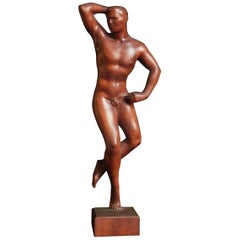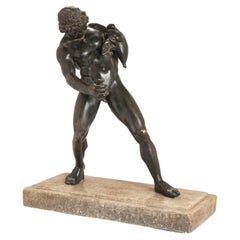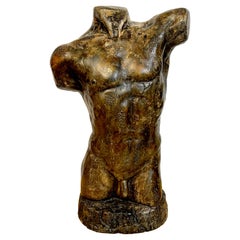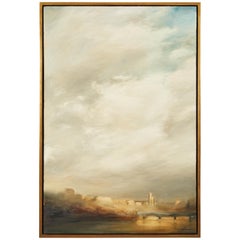Raymond Turner Furniture
to
1
1
1
1
1
1
1
1
1
1
1
1
1
1
12,059
3,892
2,416
2,231
Creator: Raymond Turner
"Artist's Model, " Rare and Important WPA Era Sculpture of Male Nude
By Raymond Turner
Located in Philadelphia, PA
Beautifully sculpted from a ruddy block of mahogany and finished with a patina that gives it a lovely glow, this piece is a superb example of WPA-era sculpture. The artist, Raymond T...
Category
1930s American Art Deco Vintage Raymond Turner Furniture
Materials
Mahogany
Related Items
Nude Male Bronze Sculpture Fountain
Located in Malibu, CA
Bronze male sculpture signed. Fonderia Giorgio Sommer Calabritto Napoli
Thomas, sculptor, lived and worked in the Naples area, and especially on Capri, from 1889 to 1906. Given this ...
Category
20th Century Italian Renaissance Raymond Turner Furniture
Materials
Carrara Marble, Bronze
French Modern Bronzed Plaster Sculpture of a Male Nude Torso
Located in West Palm Beach, FL
French modern bronzed plaster sculpture of a male nude torso, possibly a Maquette. Unsigned.
A bold, well modeled sculpture, with a beautiful patina an...
Category
20th Century French Modern Raymond Turner Furniture
Materials
Plaster
$3,080 Sale Price
20% Off
H 20.5 in W 12 in D 7 in
Grand Tour Male Nude Bronze Sculpture
Located in Houston, TX
Early 20th Century bronze male nude sculpture on wood pedestal base.
Category
20th Century Renaissance Revival Raymond Turner Furniture
Materials
Bronze
Sensual Realistic French Sculpture of Male Nude Mythological Figure Hercules
Located in Hopewell, NJ
Impressive realistic plaster statue of a muscular nude male that sits on top of a square block base. The elegant design shows intricate detail and qualit...
Category
19th Century French Renaissance Antique Raymond Turner Furniture
Materials
Plaster
$1,760 Sale Price
20% Off
H 23.5 in W 10 in D 8 in
Italian Art Deco Bronze Sculpture Of A Nude Male
Located in Houston, TX
Italian Art Deco Bronze Sculpture Of A Nude Male.
We offer a handsome Italian bronze sculpture of a reclining nude male that dates to the 1940's.
Beautiful form and great patina!
Category
1940s Italian Art Deco Vintage Raymond Turner Furniture
Materials
Bronze
Classical Bronze Male Nude Torso Sculpture/Statue
Located in Los Angeles, CA
Solid bronze male nudist statue. Classical Greek style sculpture.
Unsigned.
Would make a wonderful sculpture for desk, office, shelf, etc.
Category
19th Century Antique Raymond Turner Furniture
Materials
Bronze
Gary Weisman Nude Male Torso Bronze Sculpture
By Gary Weisman
Located in Philadelphia, PA
A fine bronze sculpture by Gary Weisman of a male nude torso.
With a mixed chocolate brown and verdigris patina.
Gary Weisman is an important living American sculptor active in Phi...
Category
Late 20th Century American Modern Raymond Turner Furniture
Materials
Bronze
Rare and important painted bronze Crucifix after a model by Michelangelo
By Michelangelo Buonarroti
Located in Leesburg, VA
A rare and very fine bronze corpus of Christ after a model by Michelangelo, cast ca. 1597-1600 by Juan Bautista Franconio and painted in 1600 by Francisco Pacheco in Seville, Spain.
The present corpus reproduces a model attributed to Michelangelo. The best known example, lesser in quality, is one on display at the Metropolitan Museum of Art (MET).
The association of this corpus with Michelangelo was first brought to light by Manuel Gomez-Moreno (1930-33) who studied the wider circulated casts identified throughout Spain. The attribution to Michelangelo was subsequently followed by John Goldsmith-Phillips (1937) of the MET and again by Michelangelo expert, Charles de Tolnay (1960).
While Michelangelo is best known for his monumental works, there are four documented crucifixes he made. The best known example is the large-scale wooden crucifix for the Church of Santa Maria del Santo Spirito in Florence, made in 1492 as a gift for the Prior, Giovanni di Lap Bicchiellini, for allowing him to study the anatomy of corpses at the hospital there. In 1562, Michelangelo wrote two letters to his nephew, Lionardo, indicating his intention to carve a wooden crucifix for him. In 1563 a letter between Lionardo and the Italian sculptor Tiberio Calcagni, mentions this same crucifix (a sketch of a corpus on the verso of a sheet depicting Michelangelo’s designs for St. Peter’s Basillica [Palais des Beaux-Arts in Lille] may reproduce this). That Michelangelo was working on small corpora in the last years of his life is further evidenced by the small (26.5 cm) unfinished wooden crucifix located at the Casa Buonarroti, considered his last known sculptural undertaking. Michelangelo’s contemporary biographer, Giorgio Vasari additionally cites that Michelangelo, in his later years, made a small crucifix for his friend, Menighella, as a gift.
Surviving sketches also indicate Michelangelo’s study of this subject throughout his career, most notably during the end of his life but also during the 1530s-40s as he deepened his spiritual roots. The occasional cameo of crucified Christ’s throughout his sketched oeuvre have made it challenging for scholars to link such sketches to any documented commissions of importance. All the while, in consideration that such objects were made as gifts, it is unlikely they should be linked with commissions.
Nonetheless, a number of theories concerning Michelangelo’s sketches of Christ crucified have been proposed and some may regard the origin of the present sculpture. It has been suggested that the corpus could have its impetus with Michelangelo’s work on the Medici Chapel, whose exclusive design was given to the master. It is sensible smaller details, like an altar cross, could have fallen under his responsibility (see for example British Museum, Inv. 1859,0625.552). Others have noted the possibility of an unrealized large marble Crucifixion group which never came to fruition but whose marble blocks had been measured according to a sheet at the Casa Buonarroti.
A unique suggestion is that Michelangelo could have made the crucifix for Vittoria Colonna, of whom he was exceedingly fond and with whom he exchanged gifts along with mutual spiritual proclivities. In particular, Vittoria had an interest in the life of St. Bridget, whose vision of Christ closely resembles our sculpture, most notably with Christ’s proper-left leg and foot crossed over his right, an iconography that is incredibly scarce for crucifixes. The suggestion could add sense to Benedetto Varchi’s comment that Michelangelo made a sculpted “nude Christ…he gave to the most divine Marchesa of Pescara (Vittoria Colonna).”
Of that same period, two sketches can be visually linked to our sculpture. Tolnay relates it to a sketch of a Crucified Christ at the Teylers Museum (Inv. A034) of which Paul Joannides comments on its quality as suggestive of preparations for a sculptural work. Joannides also calls attention to a related drawing attributed to Raffaello da Montelupo copying what is believed to be a lost sketch by Michelangelo. Its relationship with our sculpture is apparent. Montelupo, a pupil of Michelangelo’s, returned to Rome to serve him in 1541, assisting with the continued work on the tomb of Pope Julius II, suggesting again an origin for the corpus ca. 1540.
The earliest firm date that can be given to the present corpus is 1574 where it appears as a rather crudely conceived Crucifixion panel, flanked by two mourners in low-relief and integrally cast for use as the bronze tabernacle door to a ciborium now located at the Church of San Lorenzo in Padula. Etched in wax residue on the back of the door is the date, 27 January 1574, indicating the corpus would have at least been available as a model by late 1573.
The Padula tabernacle was completed by Michelangelo’s assistant, Jacopo del Duca and likely has its origins with Michelangelo’s uncompleted tabernacle for the Basilica of St. Mary of the Angels in Rome.
The impetus for the Padula tabernacle’s Crucifixion panel begins with a series of late Crucifixion sketches by Michelangelo, depicting a scene of Christ crucified and flanked by two mourners (see British Museum Inv. 1895.0915.510; Ashmolean Museum Inv. 1846.89, KP II 343 recto; Windsor Castle RCIN 912761 recto; and Louvre Inv. 700). A faintly traced block possibly intended for sculpting the sketch of the crucified Christ on its recto was discovered by Tolnay on a version of the composition at Windsor Castle. The Windsor sketch and those related to it appear to have served as preparatory designs for what was probably intended to become the Basilica of St. Mary’s tabernacle door. Vasari documents that the project was to be designed by Michelangelo and cast by his assistant, Jacopo del Duca. Michelangelo died before the commission was complete, though on 15 March 1565, Jacopo writes to Michelangelo’s nephew stating, “I have started making the bronze tabernacle, depending on the model of his that was in Rome, already almost half complete.” Various circumstances interrupted the completion of the tabernacle, though its concept is later revitalized by Jacopo during preparations to sell a tabernacle, after Michelangelo’s designs, to Spain for Madrid’s El Escorial almost a decade later. The El Escorial tabernacle likewise encountered problems and was aborted but Jacopo successfully sold it shortly thereafter to the Carthusians of Padula.
An etched date, 30 May 1572, along the base of the Padula tabernacle indicates its framework was already cast by then. A 1573 summary of the tabernacle also describes the original format for the door and relief panels, intended to be square in dimension. However, a last minute decision to heighten them was abruptly made during Jacopo’s negotiations to sell the tabernacle to King Phillip II of Spain. Shortly thereafter the commission was aborted. Philippe Malgouyres notes that the Padula tabernacle’s final state is a mixed product of the original design intended for Spain’s El Escorial, recycling various parts that had already been cast and adding new quickly finished elements for its sale to Padula, explaining its unusually discordant quality, particularly as concerns the crudeness of the door and relief panels which were clearly made later (by January 1574).
Apart from his own admission in letters to Spain, it is apparent, however, that Jacopo relied upon his deceased master’s designs while hastily realizing the Padula panels. If Michelangelo had already earlier conceived a crucifix model, and Jacopo had access to that model, its logical he could have hastily employed it for incorporation on the door panel to the tabernacle. It is worth noting some modifications he made to the model, extending Christ’s arms further up in order to fit them into the scale of the panel and further lowering his chin to his chest in order to instill physiognomic congruence. A crude panel of the Deposition also follows after Michelangelo’s late sketches and is likewise known by examples thought to be modifications by Jacopo based upon Michelangelo’s initial sculptural conception (see Malgouyres: La Deposition du Christ de Jacopo del Duca, chef-d’oeuvre posthume de Michel-Ange).
Jacopo’s appropriation of an original model by Michelangelo for more than one relief on the Padula tabernacle adds further indication that the crucifix was not an object unique to Jacopo’s hand, as few scholars have posited, but rather belongs to Michelangelo’s original...
Category
16th Century Renaissance Antique Raymond Turner Furniture
Materials
Bronze
$199,000
H 26.25 in W 11.25 in D 4 in
Anatomical Sculpture of Nude Male "L'Ecorche" after Jean Antoine Houdon
Located in Rochester, NY
An anatomical maquette of Houdon's l'Écorche (Flayed Man), after the original completed in 1767 while Houdon was a student in Rome, and the basis for his sculpture of Saint John the ...
Category
20th Century Raymond Turner Furniture
Materials
Plaster
$1,385
H 29.75 in W 8 in D 8 in
Rare and Important Italian Alabaster Bust Sculpture of Jesus Christ, C. 1860
Located in Queens, NY
A rare and important Italian alabaster bust sculpture of Jesus Christ, C. 1860
A modeled bust of Holy Christ wearing a crown of thorns, excep...
Category
19th Century Italian Baroque Antique Raymond Turner Furniture
Materials
Alabaster
$115,600
H 21 in W 11 in D 4 in
Fully Articulated Artist's Model Of Horse, Signed
Located in Bradenton, FL
Antique hand-carved artist's model of a horse, fully articulated at every level including wooden ears. Has a horsehair tail. Fixed on a brass stem and raised on a wooden base. Artist signed on base as Philippe Leo.
Category
Early 20th Century French Folk Art Raymond Turner Furniture
Materials
Wood
Nude Male Sculpture in Solid Lucite
Located in Los Angeles, CA
Introducing our stunning Nude Male Sculpture in Solid Lucite, Circa 1970's. This one-of-a-kind piece of furniture is a true masterpiece, expertly craft...
Category
1960s American Modern Vintage Raymond Turner Furniture
Materials
Lucite
Previously Available Items
‘The Calm’ by Ray Turner, 2001
By Raymond Turner
Located in San Marino, CA
‘The Calm’ by Ray Turner (1958-) painted in 2001, exhibited at DNFA Gallery as part of The Seine River Paintings collection of work.
Category
20th Century Raymond Turner Furniture
Materials
Paint
Raymond Turner furniture for sale on 1stDibs.
Raymond Turner furniture are available for sale on 1stDibs. These distinctive items are frequently made of wood and are designed with extraordinary care. There are many options to choose from in our collection of Raymond Turner furniture, although brown editions of this piece are particularly popular. Many of the original furniture by Raymond Turner were created in the Art Deco style in united states during the 20th century. If you’re looking for additional options, many customers also consider furniture by Eugene Francis Savage, Richmond Barthé, and Eduard Buk Ulreich. Prices for Raymond Turner furniture can differ depending upon size, time period and other attributes — on 1stDibs, these items begin at $4,500 and can go as high as $28,000, while a piece like these, on average, fetch $16,250.



